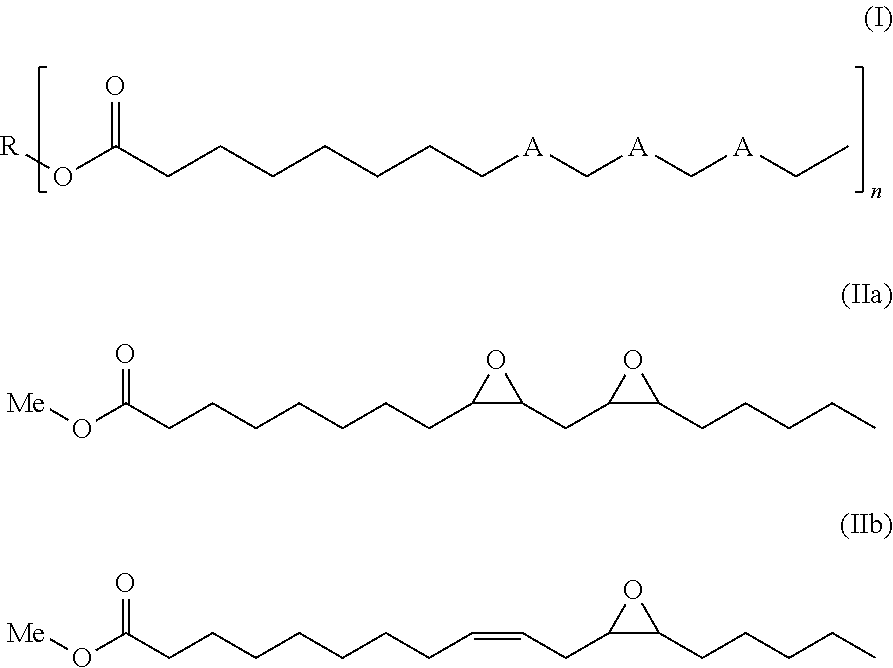Asphalt products and materials and methods of producing them
a technology of applied in the field of improved asphalt products and materials, can solve the problems of asphalt binder becoming harder and more brittle, asphalt mixture brittleness increasing, surface course aging damage, etc., and achieves the effects of reducing the carbon footprint of the asphalt mixture, reducing the emissions produced, and saving money
- Summary
- Abstract
- Description
- Claims
- Application Information
AI Technical Summary
Benefits of technology
Problems solved by technology
Method used
Image
Examples
example 1
d Methyl Soyate
[0201]Description of Blend Ingredients—For laboratory testing, an unmodified Montana crude source asphalt supplied by Jebro, with a performance grade (“PG”) of 58-28 was used as a first binder while a polymer modified form of this binder was used as a second binder—the PG 58-28 binder polymer modified with 1.5% styrene-butadiene-styrene (SBS) was used to make the PG 64-28 binder. The polymer modified PG 64-28 was blended by the binder supplier. The WMA additive was epoxidized methyl soyate supplied by Archer Daniels Midland (Decatur, Ill.).
[0202]To construct the test specimens that make up one half of each HWTD test specimen, a 10 million ESAL design level surface mix approved by the Iowa Department of Transportation (DOT) was used. Each specimen was procured with air voids at 7%±1%, diameter 150 mm and a set height of 61±1 mm. Each individual aggregate's gradation, the blended aggregate gradation, and source information used to produce this mix design are shown in Ta...
example 2
d Benzyl Soyate
[0215]Description of Blend Ingredients—
[0216]For laboratory testing, an unmodified Montana crude source asphalt supplied by Jebro, with a performance grade (“PG”) of 58-28 was used as a first binder while a polymer modified form of this binder was used as a second binder—the PG 58-28 binder polymer modified with 1.5% styrene-butadiene-styrene (SBS) was used to make the PG 64-28 binder. The polymer modified PG 64-28 was blended by the binder supplier. The WMA additive was an epoxidized benzyl soyate supplied by Archer Daniels Midland (Decatur, Ill.).
[0217]Methods—
[0218]The epoxidized benzyl soyate (EBS) was blended with the unmodified and polymer modified asphalt with a Silverson shear mill at 140° C. at 3000 rpm for one hour. The dosage level chosen was 0.75% for addition of each EBS. For example, the EBS was blended at 0.75% by total weight of the total blend.
[0219]The developed blends were then tested in accordance with ASTM and / or AASHTO for viscosity, specific gra...
example 3
d Soybean Oil
[0228]Description of Blend Ingredients—
[0229]For laboratory testing, an unmodified Montana crude source asphalt supplied by Jebro, with a performance grade (“PG”) of 58-28 was used as a first binder while a polymer modified form of this binder was used as a second binder—the PG 58-28 binder polymer modified with 1.5% styrene-butadiene-styrene (SBS) was used to make the PG 64-28 binder. The polymer modified PG 64-28 was blended by the binder supplier. The WMA additive was an epoxidized soybean oil supplied by Archer Daniels Midland (Decatur, Ill.).
[0230]Methods—
[0231]The epoxidized soybean oil (ESO) was blended with the unmodified and polymer modified asphalt with a Silverson shear mill at 140° C. at 3000 rpm for one hour. The ESO was blended at 0.75% by total weight of the total blend.
[0232]The developed blends were then tested in accordance with ASTM and / or AASHTO for viscosity, specific gravity, mass loss, performance grade, and separation. Table 7 contains the data f...
PUM
| Property | Measurement | Unit |
|---|---|---|
| temperature | aaaaa | aaaaa |
| temperature | aaaaa | aaaaa |
| temperature | aaaaa | aaaaa |
Abstract
Description
Claims
Application Information
 Login to View More
Login to View More - R&D
- Intellectual Property
- Life Sciences
- Materials
- Tech Scout
- Unparalleled Data Quality
- Higher Quality Content
- 60% Fewer Hallucinations
Browse by: Latest US Patents, China's latest patents, Technical Efficacy Thesaurus, Application Domain, Technology Topic, Popular Technical Reports.
© 2025 PatSnap. All rights reserved.Legal|Privacy policy|Modern Slavery Act Transparency Statement|Sitemap|About US| Contact US: help@patsnap.com



